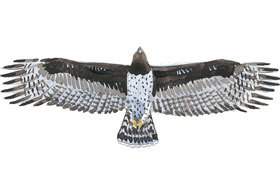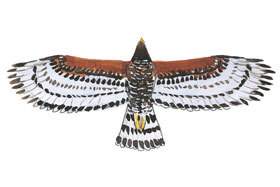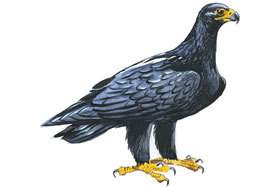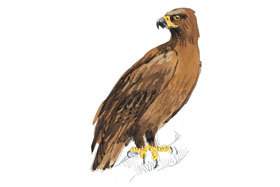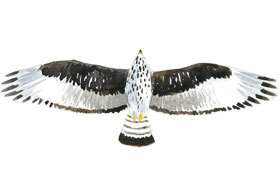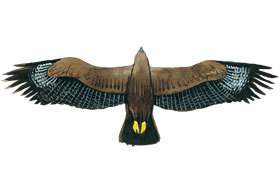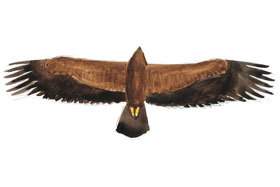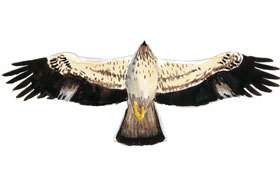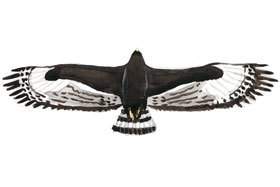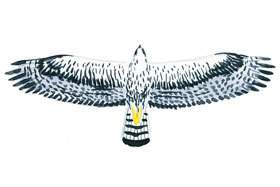
Martial Eagle (Polemaetus bellicosus)
Afrikaans: Breëkoparend
The Martial is the most commonly seen of the Big Three, occurring throughout the Park. It is the largest of the African eagles with a tip-to-tip wingspan of up to 2.6m. Its military-like bearing and powerful hunting skills make it a highly impressive raptor.
There are an estimated 256 resident pairs in Kruger with each pair nesting at least nine kilometres apart. It spends much of its time soaring, often covering distances of up to 100 square kilometres a day, preying on game birds, reptiles and small animals.
According to birding author Richard Liversidge, the heaviest recorded prey of a Martial was an antelope weighing almost 37kg, which the eagle killed and ate on the ground. One of the Martial's favourite foods is the water monitor or leguaan.
Martial Eagles are usually shy, silent and monogamous. Pairs breed between April and August, building large nests lined with green leaves in the main fork of a large tree - often a Knob-thorn. One egg is usually laid and takes up to 50 days to incubate. Chicks are fed mostly by the larger female, while the male provides the food.
Martial Eagle Characteristics
Adult Height
78-83cm
Weight
3-4.7kg
Wingspan
1.95-2.6m
Large head; back and chest are dark brown; distinctive white underparts with dark spots; in flight it appears mostly dark with white belly and a short tail with narrow barring.
Resident
Prey
Prey consists of forty-five percent birds, particularly game birds and Egyptian Geese; thirty-eight percent reptiles - mainly snakes and leguaans; and seventeen percent mammals such as mongooses, baboons, young warthog and impala lambs.
Where best to find them
Throughout Kruger, particularly in the eastern grasslands and flat open woodlands where prey is plentiful; also along watercourses in search of leguaans.
African Crowned Eagle (Stephanoaetus coronatus)
Afrikaans: Kroonarend
The African Crowned Eagle has a bigger body than Verreauxs' Eagle but a smaller wingspan, which is an adaptation to its preferred habitat - thick, riverine bush. It will not hesitate to swoop through dense bush canopy to get its prey.
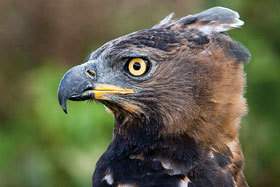 The smaller wings give it more manoeuvrability when flying low through the forest than those raptors with larger wings. Its colouring is also suited to the habitat - the mottled chest fits in well with the dappled sunlight of riverine forests.
The smaller wings give it more manoeuvrability when flying low through the forest than those raptors with larger wings. Its colouring is also suited to the habitat - the mottled chest fits in well with the dappled sunlight of riverine forests.
This powerful bird is reportedly stronger than both the Verreauxs' and Martial Eagles. Like them, the African Crowned Eagle is a collaborative hunter - one bird flies low over the trees to cause panic amongst a troop of monkeys, while its mate attacks from the other side.
Any monkey caught off guard will be seized by the skull and killed instantly before being taken back to the nest for shared consumption. Pairs are closely bonded and use the same nest year after year. It is a very vocal bird, calling kwee kwee kwee during its quite spectacular breeding season displays.
Traditional healer Didiza Dube has reported seeing the African Crowned Eagle on an ants' nest, spreading its wings and breast feathers to allow the insects to climb over its body. It is believed the bird does this to agitate the ants into releasing formic acid, which kills parasites on the skin or feathers.
African Crowned Eagle Characteristics
Adult Height
80-90cm
Weight
3.6kg
Wingspan
2.1m
Crowned head, dark colouration, mottled chest; well-rounded wings in flight and a long, barred tail.
Resident
Prey
About ninty-six percent of diet consists of mammals, partituclarly monkeys, mongooses, dassies and occasionally young antelope; otherwise birds and occasionally reptiles; will sometimes dismember prey and hide portions in trees for future use.
Where best to find them
Favours riverine forest - particularly Luvuvhu and Limpopo Rivers; occurs sporadically elsewhere.
Verreauxs' Eagle* (Aquila verreauxii)
Afrikaans: Witkruisarend
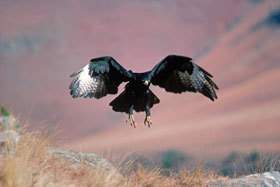 Verreauxs' Eagle* - formerly known as the Black Eagle - occupies a significant place in Shangaan and Shona mythology as a messenger of the ancestors. It is a large raptor found in mountainous terrain, nesting on cliff faces.
Verreauxs' Eagle* - formerly known as the Black Eagle - occupies a significant place in Shangaan and Shona mythology as a messenger of the ancestors. It is a large raptor found in mountainous terrain, nesting on cliff faces.
There are an estimated 240 breeding pairs in north-east South Africa. Verreauxs'* are usually found in pairs as they form life-long partnerships. They hunt collaboratively, with the lead bird trying to flush the prey into the open for the other bird to ambush. They then share the spoils.
Verreauxs'* is the most prey-specific of raptors, with most of its diet consisting of dassies that are hunted in the early morning or late afternoon when these little animals come out to sun themselves. According to Ken Newman, a pair and their chick may eat up to 400 dassies a year.
Recent studies indicate its diet is more varied than previously thought with tortoises being a favoured delicacy - they are seized and dropped onto rocks to break their shells. There is one record from Namibia of a pair of Verreauxs' Eagles* who drove a kudu calf off a cliff face and then consumed it.
Verreauxs' Eagle Characteristics
Adult Height
82-96cm
Weight
3.7-4.5kg
Wingspan
2m
Characteristic white V shape on the back. Yellow ceres and feet.Resident
Prey
Between fifty and ninty percent of diet consists of dassies; also known to take tortoise, mongoose, vervet monkeys, baboons, monitor lizards and birds such as guineafowl, francolins and bustards.
Where best to find them
Confined mostly to the north, particularly Nyala Drive on the Luvuvhu River where there are nests in the cliffs; also recorded in the Lebombo and mountains around Berg-en-Dal.
Tawny Eagle (Aquila rapax)
Afrikaans: Roofarend
The Tawny Eagle is a shaggy, solitary bird that spends much of the time perching quietly. It is one of the most common raptors throughout the Park, except in dense, woodland areas. There are about 670 residents in Kruger, each covering a territory of about 70 square kilometres. In Kruger, the Tawny is primarily a scavenger, with studies showing that 65% of its diet consists of the remains of antelope and other ungulates.
It is also an active pirate always ready to steal a morsel from another bird. Its scavenging habits do not detract from its hunting skills. A Tawny Eagle is capable of killing a small four-kilogram warthog and has been seen taking out a flamingo in mid-flight.
Tawny Eagle Characteristics
Adult Height
65-77cm
Weight
1.6-2.4kg
Wingspan
1.7-2m
Tawny colouring but quite variable; is lighter than the Steppe Eagle with which it is often confused; yellowish gape extends only to mid-eye; eyes are pale yellow; feathered legs.Resident
Prey
Has a broad diet but live prey consists mostly of birds, small mammals like rodents and rabbits; also reptiles and insects.
Where best to find them
Throughout the Park, particularly well-wooded areas; avoids dense forests.
Brown Raptor Spotting Tips
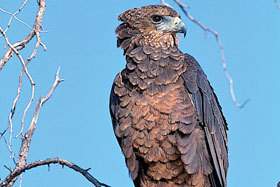
Telling the difference between the seven brownish eagles with yellowish beaks can sometimes be tricky. The juveniles of some species can often get confused with adults of another. Look for the following characteristics:
- Piercing, yellow eye and yellow ceres; black beak, slight crest and bare, whitish legs (tarsus) without feathers; erect stance when perched (Brown Snake-Eagle)
- Yellow eye less intense; yellow beak; unfeathered legs and short tail (juvenile Bateleur)
- Yellow eye less intense; yellow beak, unfeathered legs, longer tail; paler on the upperparts and noticeably rufous chest (juvenile Black-chested Snake-Eagle)
- Yellow beak with black tip; large body; feathers covering the whole leg; yellow toes (Tawny Eagle)
- Prominent yellow gape under the eye; large body; feathers covering the legs; seen only in summer (Steppe Eagle)
- Variety of shades of brown, but in flight it has a noticeably narrow, square-ended tail (Wahlberg's Eagle)
- Variety of shades of brown, but in flight it has a noticeably short, rounded tail (Lesser Spotted Eagle)
- Brown eagle at perch with unusually thin-looking, semi-feathered legs (Lesser Spotted Eagle)
African Hawk-Eagle (Aquila spilogaster)
Afrikaans: Grootjagarend
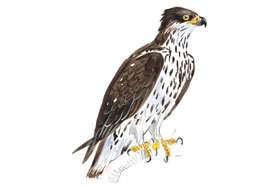 Kruger has the highest densities of African Hawk-Eagles in southern Africa, with an estimated 1 100 birds. This bird is highly possessive - of its mate, its nest and its territory - and will attack humans who venture too close. In Kruger, nests are at least five kilometres apart. It soars conspicuously in the morning, often in pairs, and then sits for most of the day in the forest canopy, keeping an eye out for movements in the bush below.
Kruger has the highest densities of African Hawk-Eagles in southern Africa, with an estimated 1 100 birds. This bird is highly possessive - of its mate, its nest and its territory - and will attack humans who venture too close. In Kruger, nests are at least five kilometres apart. It soars conspicuously in the morning, often in pairs, and then sits for most of the day in the forest canopy, keeping an eye out for movements in the bush below.
The African Hawk-Eagle likes to hunt guineafowl and other game birds by flushing them from the grass cover, then giving them a chance to settle before swooping down on them. It will also hunt turacos, hornbills, occasionally owls and, like most other raptors, will raid colonies of Red-billed Quelea. It is not a very vocal bird but when it does call it has a musical-sounding klee klee klee.
African Hawk Eagle Characteristics
Resident
Prey
Seventy percent of its diet consists of game birds, particularly guineafowl; also eats small mammals like vervet monkeys, squirrels, bushbabies and rodents, as well as reptiles and insects.
Where best to find them
Throughout the Park but particularly in wooded savannah and mopaneveld in northern Kruger; also around Biyamiti, Berg-en-Dal and Malelane in the south.
Wahlberg's Eagle (Aquila wahlbergi)
Afrikaans: Bruinarend
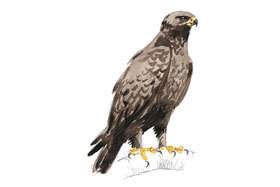 One of the most common eagles in Africa, Wahlberg's Eagle is a summer visitor to Kruger from north Africa. Migrating flocks are regularly recorded flying down the Great Rift Valley to their southern hunting grounds in the well-wooded habitats of Kruger. A Wahlberg's tagged in the Park took 42 days to return to its northern breeding site in Chad, flying north up the Rift and crossing the DRC. Its arrival usually coincides with the first regular summer rains.
One of the most common eagles in Africa, Wahlberg's Eagle is a summer visitor to Kruger from north Africa. Migrating flocks are regularly recorded flying down the Great Rift Valley to their southern hunting grounds in the well-wooded habitats of Kruger. A Wahlberg's tagged in the Park took 42 days to return to its northern breeding site in Chad, flying north up the Rift and crossing the DRC. Its arrival usually coincides with the first regular summer rains.
Wahlberg's is an agile and opportunistic hunter with diverse tastes. It hunts from the perch and the wing, often soaring to great heights and making spectacular swoops upon its prey. A split second before impact it opens its wings, which act as a brake as it strikes its victim. Wahlberg's is a vocal raptor, often calling with a loud, fluting kleeee-ee.
Studies by Peter Steyn indicate that Wahlberg's Eagle breeds in Kruger. The birds construct a nest and lay eggs soon after their August or September arrival. Hatchlings are able to stand up and flap their wings after a month and can fly after about 70 days, which is quite a long period for a raptor. By the time Wahlberg's migrates northwards again in March or April, the juvenile bird is able to make the trip by itself.
Whalberg Eagle Characteristics
Migrant
Prey
Game birds and doves dominate the diet but also partial to small mammals like the mongoose, squirrels and rodents; also snakes and other reptiles, frogs and insects.
Where best to find them
Common throughout Kruger in summer, especially around Skukuza, south Kruger and in the central plains.
Steppe Eagle (Aquila nipalensis)
Afrikaans: Steppe-arend
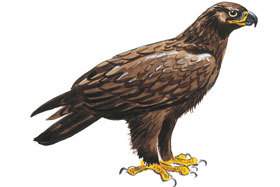 The Steppe Eagle is a powerfully built bird that breeds in the Russian Steppes during the European summer and arrives in southern Africa in late October or early November. It is not a very common sighting in Kruger and its movements appear to be dictated by summer rains.
The Steppe Eagle is a powerfully built bird that breeds in the Russian Steppes during the European summer and arrives in southern Africa in late October or early November. It is not a very common sighting in Kruger and its movements appear to be dictated by summer rains.
In the Park it has been most often recorded in the open eastern grasslands, which are similar to its home habitat. It is a gregarious bird often travelling in flocks. It usually makes its departure back north in late March or early April.
The rains are an important feeding trigger for the Steppe Eagle. After the rain, millions of termites burst from underground into the open, attracting scores of Steppe Eagles, which then gather in a feeding frenzy. These termite eruptions usually attract a host of raptors, including the Yellow-billed Kite and Lesser Spotted Eagle.
They are particularly fond of the northern harvester termite (Hodotermes mossambicus), which they often pursue on the ground 'lumbering after their minuscule quarry in ludicrous fashion' in the words of birding author Peter Steyn. According to Steyn, termites are an important nutritious component for the Steppe Eagle, which has the dexterity of claw to catch them in mid-flight. He says a Steppe Eagle requires between 1 600 and 2 200 termites to fill its daily requirements. On a good day it can do this within three hours.
Steppe Eagle Characteristics
Migrant
Prey
Game birds and doves dominate the diet but also partial to small mammals like the mongoose, squirrels and rodents; also snakes and other reptiles, frogs and insects.
Where best to find them
Common throughout Kruger in summer, especially around Skukuza, south Kruger and in the central plains.
Lesser Spotted Eagle (Aquila pomarina)
Afrikaans: Gevlekte Arend
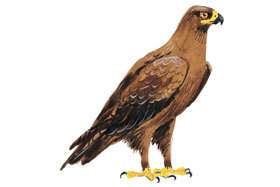 The Lesser Spotted Eagle flies south from its Baltic breeding grounds from mid-October. Sources quoted by Roberts VII say a Lesser Spotted Eagle ringed in Kruger was found near the Caspian Sea.
The Lesser Spotted Eagle flies south from its Baltic breeding grounds from mid-October. Sources quoted by Roberts VII say a Lesser Spotted Eagle ringed in Kruger was found near the Caspian Sea.
Its southward flight takes approximately 50 days, while its return migration in March takes twice as long (See The Distance Champion of Raptors). It is a strong, soaring bird often seen with other raptors in a thermal. It follows the rain fronts as these induce termite eruptions, which are its main source of food. It is often seen termite feeding on the ground.
The Lesser Spotted Eagle occurs in the same summer nesting grounds as the Steppe Eagle in eastern Kruger's lightly wooded savannah, and the two species are often found in mixed flocks. It avoids mountainous areas and wetlands.
Lesser Spotted Eagle Characteristics
Migrant
Prey
Mostly termites but sometimes small birds, rodents and frogs; often goes after Red-billed Quelea nestlings.
Where best to find them
Well-wooded regions throughout Kruger; particularly eastern grasslands.
Booted Eagle (Aquila pennatus)
Afrikaans: Dwergarend
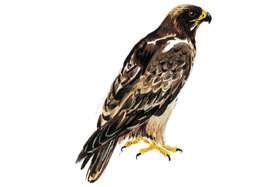 The Booted Eagle is a summer migrant rarely seen in Kruger as it prefers the drier, mountainous habitats of the western Cape where there is a breeding population. The very few Booted Eagles that have been seen in Kruger are most likely northern hemisphere migrants that breed in north Africa and southern Eurasia.
The Booted Eagle is a summer migrant rarely seen in Kruger as it prefers the drier, mountainous habitats of the western Cape where there is a breeding population. The very few Booted Eagles that have been seen in Kruger are most likely northern hemisphere migrants that breed in north Africa and southern Eurasia.
They arrive in southern Africa usually during the course of November and depart in February before the end of the rainy season. The Booted Eagle has a high-pitched, trilling pee pee pee pee call.
Booted Eagle Characteristics
Migrant
Prey
Fifty percent of diet consists of birds up to the size of a sandgrouse; also eats lizards and rodents.
Where best to find them
Rare in Kruger; widely scattered records exist.
Long-crested Eagle (Lophaetus occipitalis)
Afrikaans: Langkuifarend
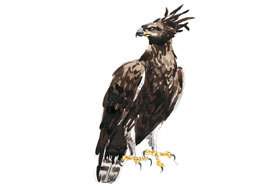 The Long-crested Eagle is more common in the escarpment than in the Park and sightings are generally restricted to the western parts of Kruger on the edge of mixed woodlands and around marshland. It is a conspicuous percher with an unmistakable crest. There are an estimated 200 pairs in north-eastern South Africa. Pairs are monogamous but generally nest individually.
The Long-crested Eagle is more common in the escarpment than in the Park and sightings are generally restricted to the western parts of Kruger on the edge of mixed woodlands and around marshland. It is a conspicuous percher with an unmistakable crest. There are an estimated 200 pairs in north-eastern South Africa. Pairs are monogamous but generally nest individually.
Its home range is small compared to some of the other raptors - an estimated 35 square kilometres in the Mpumulanga region. It usually hunts from a favourite perch early in the morning or late in the afternoon, spending most of the rest of the day in shade. It feeds mostly on small, terrestrial animals, rarely preying on birds. It has a high pitched kee-ah call.
Long-crested Eagle Characteristics
Resident
Prey
Rodents, small snakes, frogs and lizards.
Where best to find them
Not common in Kruger; prefers wooded and marshy habitats; recorded in south-western foothills, along the Crocodile River, also near Punda, in the Satara vicinity and in the Lebombo.
Ayres's Hawk-Eagle (Aquila ayresii)
Afrikaans: Kleinjagarend
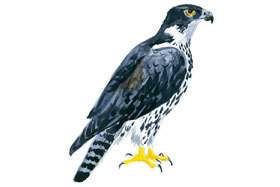 This is a rare visitor to Kruger and is more commonly seen north of the Limpopo. According to Peter Steyn, it is the swiftest of all southern African eagles 'combining the speed of a large falcon with the manoeuvrability of a sparrowhawk' and in the tree canopy 'weaves in and out of the branches without any slowing down, often emerging with a bird it has caught'.
This is a rare visitor to Kruger and is more commonly seen north of the Limpopo. According to Peter Steyn, it is the swiftest of all southern African eagles 'combining the speed of a large falcon with the manoeuvrability of a sparrowhawk' and in the tree canopy 'weaves in and out of the branches without any slowing down, often emerging with a bird it has caught'.
Roberts VII carries an account of an Ayres's killing a White-faced Duck in mid-flight by surprising it from below, then turning upside down beneath it before seizing it in its talons. Ayres's Hawk-Eagles put on great, soaring, courtship displays with the male often descending from a great height through the tree canopy to find the female.
Ayres's Hawk Characteristics
Migrant and Resident
Prey
Mostly small birds from bulbuls to pigeons; seems to often go for birds up to the size of a guineafowl.
Where best to find them
Rare in Kruger, occasionally seen over the edge of dense, rocky woodlands in the extreme north and south; possible nesting site between Crocodile Bridge and Biyamiti.

